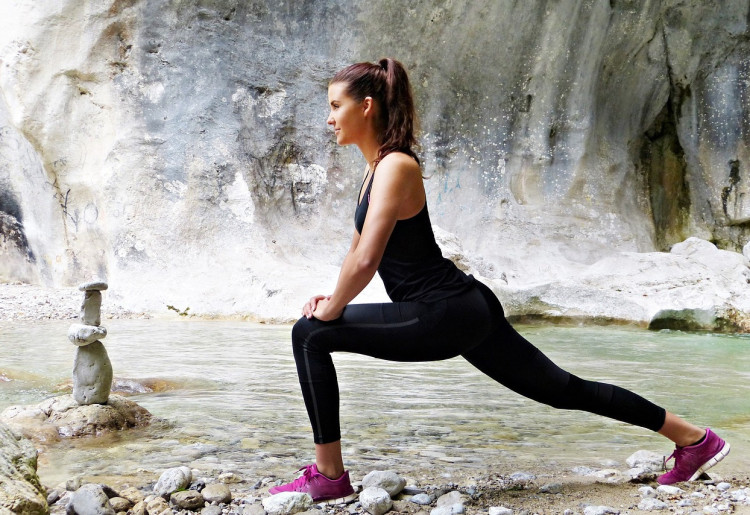With summer now just around the corner, now is a great time to rejuvenate your healthy eating and activity goals.
Danielle Bowman, dietitian with Jenny Craig, says smart long-term habits are the key to maintaining a healthy lifestyle and keeping your weight under control. “Don’t try to do too much, challenge yourself to implement just one habit per week,” she says. “You’ll kick off the first month of summer feeling fantastic, instead of trying to play catch up once the indulgent festive season is over.
“It’s also a good idea to commit to a health goal and ask a friend to keep you accountable. Explain to them that you want to add one thing below each week and ask them to help motivate you.”
Here are Danielle’s top tips. Plus don’t forget to check out the great veggie recipe below.
1. Don’t skip breakfast
If you don’t eat breakfast and know it impacts your afternoon and evening eating, then you might benefit from regularly including this morning ritual.
Starting your day with a small nutritious meal is a really good way to get at least three of the five core food groups in. Cereal with milk and a handful of fruit will cover it, as will toast with peanut butter, sliced banana and a small milk coffee.
Breakfast helps to curb your hunger, and it also commits you to a regular meal pattern. Research has shown that not skipping a meal can help you to avoid overeating later in the day, which has positive effects on your overall kilojoule intake.
2. Eat more vegetables
Vegetables are filling, low in kilojoules, contain antioxidants, phytonutrients and prebiotics for good gut health. Good gut health is connected to having a diverse microbiome, which means a large number and wide variety of good bacteria in your gut. In short, a plant-rich diet means a happy gut.
Fresh, seasonal vegetables are an integral part of the Mediterranean Diet, a way of eating that has been shown to offer anti- inflammatory benefits, reduce the incidence of heart disease, improve the management of diabetes, and also help you to lose weight.
Vegetables should fill half of your plate at main meals, with one quarter for your protein portion, and the other quarter carbohydrates. Remember that starchy vegetables such as potato, sweet potato and corn count as carbohydrates, so focus on adding more green vegetables, red vegetables, the brassicas (e.g. broccoli) and leafy salads to your plate.
3. Have healthier food options on hand
Stimulus control can change your behaviour. Keep those high kilojoule, less nutritious foods out of sight, and surround yourself with healthier food options and you will begin to change the foods you choose to eat. A little planning will ensure you have healthier foods available at home, at your desk, and in your car or bag (for when you’re out and about).
Options such as fresh fruits and vegetables, nuts, seeds, wholegrain crackers and unflavoured dairy foods will leave you feeling fuller for longer as well as giving your body the nutrients and long-lasting energy it needs.
4. Problem-solve barriers
Many of us are resistant to change. Putting new habits into place requires effort and commitment, and we often find barriers in our way. If you’re having trouble making changes, ask yourself why, and brainstorm some possible solutions. For example:
Problem: Lacking time for breakfast in the morning.
Solutions: Make a smoothie if you need a breakfast on the go. Make overnight oats ready for the morning. Get up 15 minutes earlier to sit down and enjoy this meal.
Problem: Vegetables take too much time to prepare.
Solutions: Buy prewashed salad ingredients, and simply add some fresh tomato. Buy pre-cut stir fry vegetables to have on hand for your next meal.
5. Drink more water
Water is the recommended drink of choice. Not only does it keep your body well hydrated, but it can also have an impact on how much you eat.
As we fill our stomach, appetite reduces, especially if you eat slowly and tune in to how your stomach is feeling. There are a number of factors that contribute to the sensation of fullness. It can be the nutrients in food—for example, protein has been shown to keep you feeling fuller for longer—but it is also related to the physical volume of foods and drinks in your stomach. A glass of water before a meal adds volume, and studies have shown it can reduce the number of kilojoules you eat at that meal
6. Get more active
Getting back into planned physical activity after a long and cold Winter can be hard. Tracking your steps will give you a baseline to start from, then you can look for opportunities to do more. Aiming for 8000-10,000 steps is a good long-term goal—but start where you’re at. Take your current steps and add ten percent each week, so if you’re currently doing 5000, add 500 the next week, and so on.
Look for opportunities to be more active in your everyday life: park further away, stroll through the park in your lunch break, have a walking coffee with a friend.
Once your steps stack up, you’ll begin to see yourself as more active and the positive effects will keep flowing.
7. See yourself as healthier
What you choose to see and believe, very often becomes your reality. It was Confucius who once said “Those who say they can, and those who say they can’t, are both usually right”.
Begin to see yourself as someone who makes healthier food choices, who prioritises physical activity as a regular part of your week, who makes conscious decisions that will benefit your health and wellbeing.






















6:50 pm
10:08 pm
2:29 pm
1:52 pm
11:50 am
9:56 pm
-

-
-
Ellen replied
- 30 Oct 2022 , 8:50 am

Reply7:57 pm
6:51 pm
5:53 pm
10:15 pm
3:57 pm
8:46 am
9:37 pm
-

-
-
Ellen replied
- 29 Oct 2022 , 7:28 am

Reply6:38 pm
4:07 pm
-

-
-
Ellen replied
- 28 Oct 2022 , 8:50 am

Reply11:10 am
9:31 am
8:59 am
6:37 am
- 1
- 2
- »
Post a commentTo post a review/comment please join us or login so we can allocate your points.